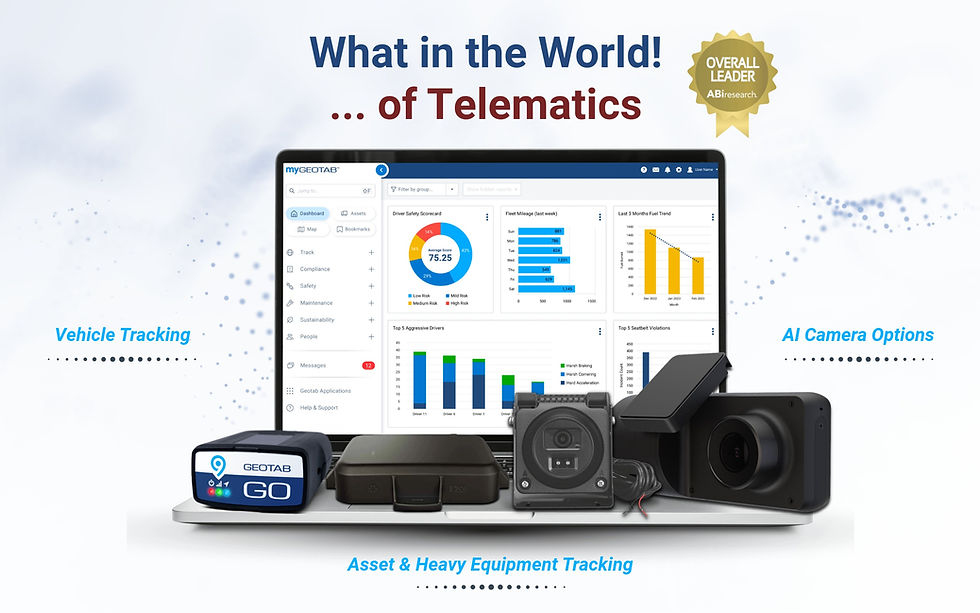4 Fixes for Driver Objections to Telematics
- eric4380
- Jan 15, 2019
- 3 min read

Author: Mark Pyle, Partner Account Manager
Fleet tracking can be a sensitive topic for drivers. Some drivers may believe that management are watching every move so they can criticize or punish employees, leading to driver objections to telematics.
But that is not the case when it comes to Geotab. It’s not just about breadcrumb trails! In fact, telematics can be a means of tracking success and rewarding good performance and improvements in productivity, efficiency or safety.
To help managers respond to resistance, we pulled some real-world examples from our Geotab success stories.
Understanding the Driver Perspective
Drivers who have been working a long time and used to doing things a certain way may be skeptical of change. Or, they aren’t tech savvy and are intimidated. Other drivers may have just found a comfort zone and don’t want to upset their routine.
You may hear: “When things have gone so well, why change now?”
Another common objection from drivers is that GPS tracking will add work to their already busy day.
The introduction of electronic logging in the U.S. has caused its own challenges for companies in the trucking industry, as it required drivers to switch from papers logs to electronic logging.
However, business priorities of complying to regulations and staying competitive override driver preferences in this case. What can fleet managers do?
Four Strategies for Overcoming Driver Objections to Fleet Tracking
1. Set Clear Rules How do you implement telematics smoothly for 2,500 drivers and operators of varying skill and experience? Trans-Adriatic Pipeline (TAP) achieved this and more — reaching a milestone of 15 million kilometers driven without a serious road accident. One key to their success was setting a series of non-negotiable rules and requirements for driver safety and environmental impact. TAP also created specific speed rules by region and vehicle type, using custom zones in MyGeotab.
2. Emphasize Time-Saving MasTec Advanced Technologies (MasTec AT) needed greater visibility of their fleet to improve fleet efficiency and safety. The communications and infrastructure installation fleet has over 4,500 drivers who travel almost 100 million miles per year. A major benefit for drivers was the time saved on administrative tasks. Instead of taking time away from work, telematics allowed drivers to focus more on safety and getting the job done.
3. Keep Communication Channels Open Black & Veatch, a global engineering and construction company with over 450 fleet vehicles, knew that communication was essential. Right from the start, the company included drivers and shared the goals of the telematics program with them. Regular conference calls, manager support and regular feedback were all part of the plan to engage drivers.
The result: Black & Veatch saw a 28% improvement in their average fleet safety score and lowered their accident rate from over 5 to 3 accidents per million mile.
4. Provide Driver Incentives Employee incentives or recognition programs, either formal or informal, may be developed based on driver safety scorecards. Customers may opt for various types of reward, anything from gift cards and plaques, company recognition for achievements, or even something as simple as donuts at staff meetings. It’s all about getting the solution in place and using the data to help drivers.
Petroleum delivery company Fueliner users enhances their driver training program with positive recognition for improvement and safe driving behavior. This strategy has contributed to their telematics success story of increased driver safety and cost savings on insurance.
Conclusion
There are different reactions when new technology is brought upon people. Some are for it, while others are completely against it. Some individuals love routine and are not happy when it is disrupted. That is why people may take some time to get used to new technology.
Companies that invest in fleet tracking may be mistaken as being intrusive to their employees. However, open communication and regular reviews of the safety information with drivers can support driver participation and acceptance.
Educating drivers about telematics benefits such as reduced risk of accidents or vehicle breakdowns and increased productivity is important to overall success. Make conversations with drivers encouraging and positive. Let your drivers know that this is a necessary change that ultimately saves them from sticky situations.
Request a demo today to learn more.




Comments